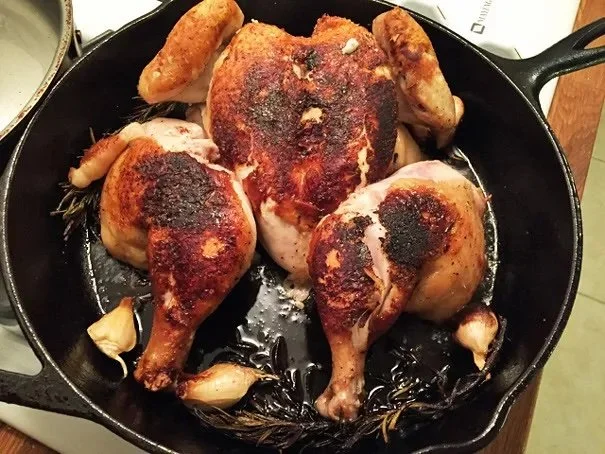Chicken Under A Brick (Or A Cast Iron Skillet)
Scared you, didn’t I? Well I didn’t mean to. It’s funny how many people read my last post and assumed I was ending my blog. That’s not what I said! I just said that my blog was no longer my primary source of income; in many ways, it’s a liberating state of affairs. It means that if I post on here (as I’m doing now) it’s because I have something I’m really eager to share with the world, not just something to fill up space on the internet (like that time I told you that my cake stand is really a punch bowl; though, weirdly, that post really caught on). In any case: chicken under a brick. Have you tried it? If not, why not? I bet I can guess: you’re afraid. I was afraid too. Then, this past Tuesday, I tried it and–I mean this seriously–I don’t think I’ll ever make chicken any other way again.
Think of all the things that you want a chicken to be when you cook it: really crispy on the outside, really moist on the inside, and packed with flavor. Chicken Under A Brick achieves all three things and does it in less time than your standard roast chicken. It also requires only a few ingredients: a chicken, some garlic, some rosemary, and a lemon. The only thing it requires that you might not have is kitchen courage. Let me help you with that.
Preheat your oven to 500 degrees. Get out two cast iron skillets (note: you can use real bricks instead of the 2nd skillet, you just wrap them in foil. But who has bricks?). Heat the larger one on medium high heat. Meanwhile, cut the backbone out of a 3 1/2 to 4 pound chicken. (Wrap it in plastic and freeze it for stock.) Season the chicken all over with lots of salt and pepper.
When the skillet is pretty hot, pour in 1/4 cup of olive oil and add some whole garlic cloves (still in their skin, so they don’t burn; Mark Bittman’s recipe has you add lots of chopped up garlic which blows my mind, because that garlic is going to burn and become disgusting after this process…you don’t want that) and some rosemary. This perfumes the oil. (Note: my recipe is a synthesis of Mark Bittman’s recipe, an Amanda Hesser video, and some other stuff I read online.)

The idea here is that you’re perfuming your oil. After 30 seconds, use a wooden spoon to push the rosemary and garlic aside and then lay your chicken in breast-side down. The legs and thighs should be flattened too so that the most amount of chicken that could possibly be touching the hot oil is doing so. Then you place a heavy cast iron skillet on top and press down! (Note: you can lay a piece of parchment down on top of the chicken so you don’t dirty the second skillet.)

Push hard because that’s what’s going to make the magic happen. You could weigh down the top skillet with some cans, but this is all going into the oven so the cans won’t work in there. Let the chicken cook like this on the stove top for 5 minutes.
Really, this recipe is all about faith. Because you have to trust that a chicken cooking like this in hot oil is not going to burn. But after five minutes, you transfer this whole heavy thing (this is the hardest part: use lots of oven mitts and towels to lift this up; you may have to touch the bottom of the heavier skillet, so really protect your hands) and into the oven. Leave it in there for 15 minutes.
After 15 minutes, you take everything out of the oven, lift off the top skillet, and with a pair of tongs flip the chicken over. You’ve seen this image before at the top of this post but let me show you again:
It’s really a glorious sight. Never have I seen a chicken in my own kitchen so bronzed, so crackling on the surface. You stick that chicken back into the 500 degree oven–breast side up–to finish cooking. Keep an eye on it because that high heat may take your bronze to black; use a meat thermometer to see when it’s 165 between the leg and the thigh.
To serve, take a tip from Amanda Hesser. Lift the chicken out of the skillet and allow to rest on a plate. Meanwhile, you have all these glorious browned bits on the bottom of the cast iron skillet but, as Amanda points out, you can’t add acid to that or it’ll corrode the surface and make for a muddy sauce. So add water–about 1/2 a cup–to the skillet, turn up the heat, and bring to a boil, working up the brown bits with a wooden spoon.

When it’s reduced significantly, pour that liquid into another skillet or a small pot and add the juice of one lemon and a pat of butter. Reduce that until it tastes wonderful.
To serve, place some chicken on a plate, pour on the sauce, and serve with roasted potatoes or–as I did here–a big pile of arugula dressed simply with good olive oil and more lemon juice.

It’s my new favorite dinner; definitely something worth blogging about. Even the cat will rave.


